
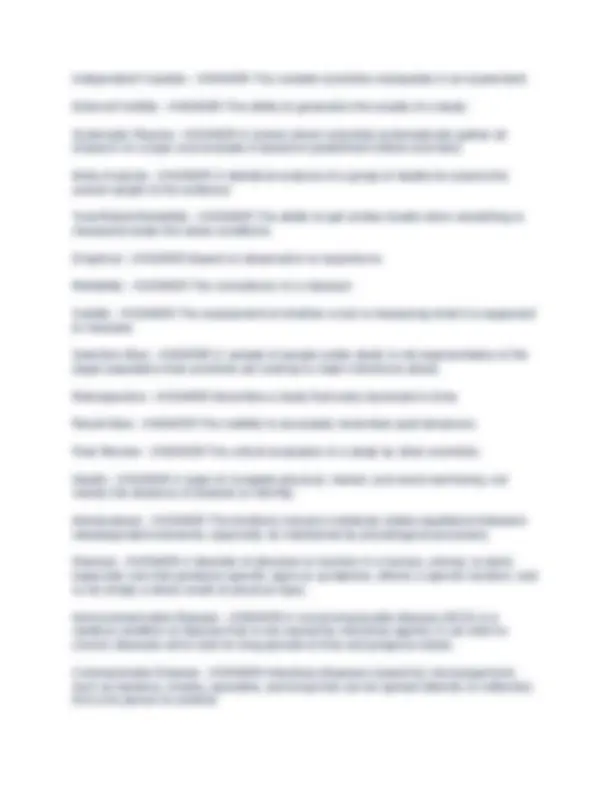
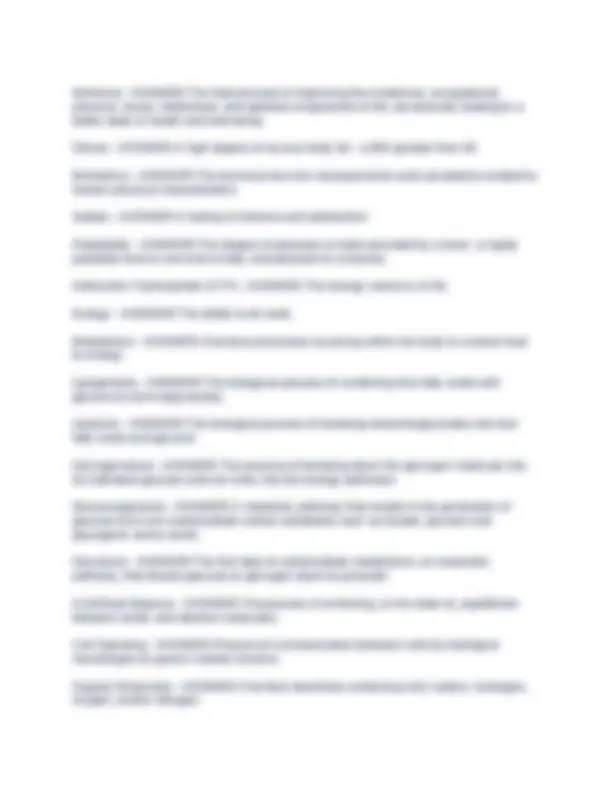
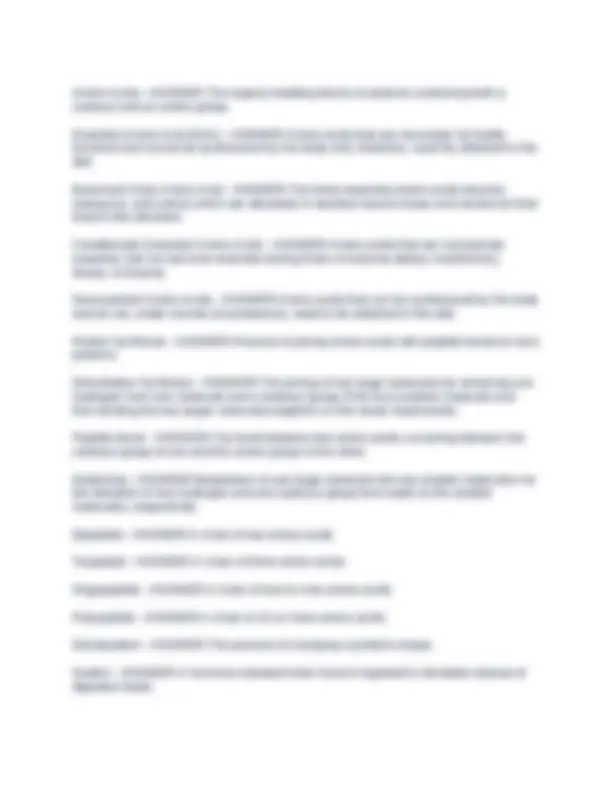
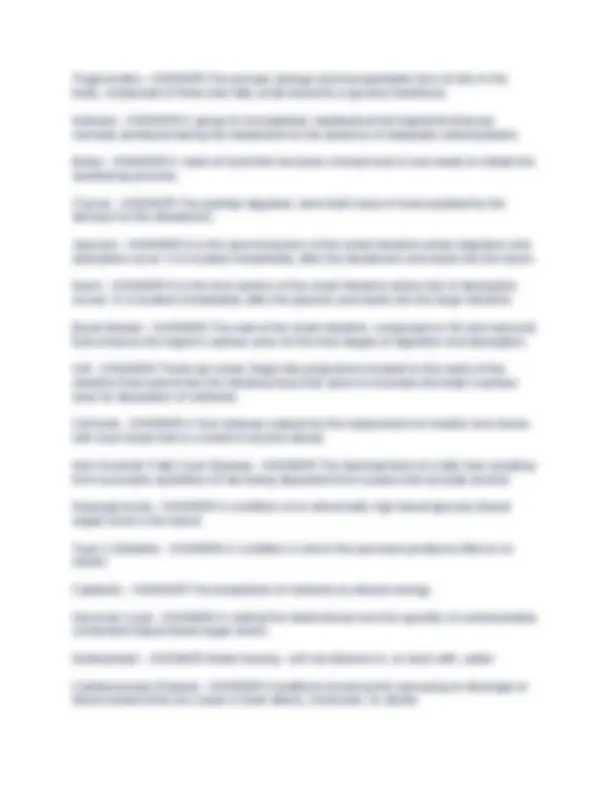
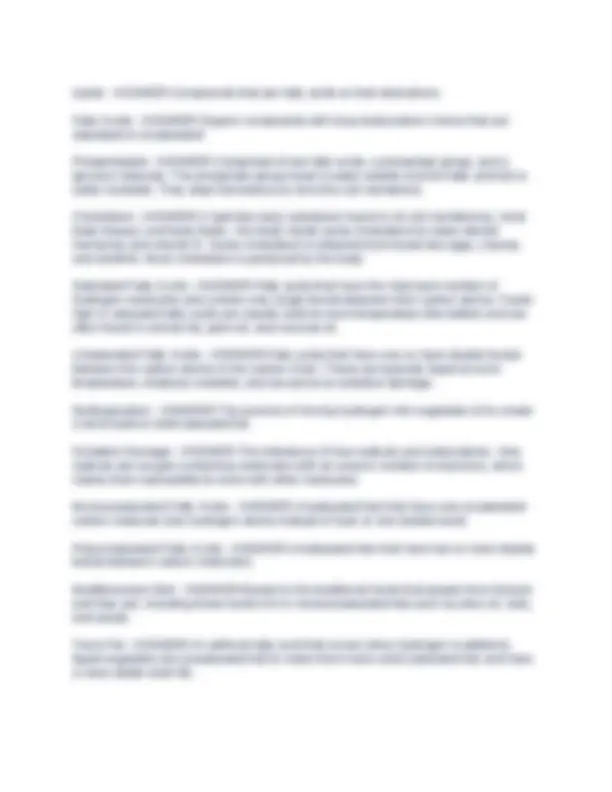
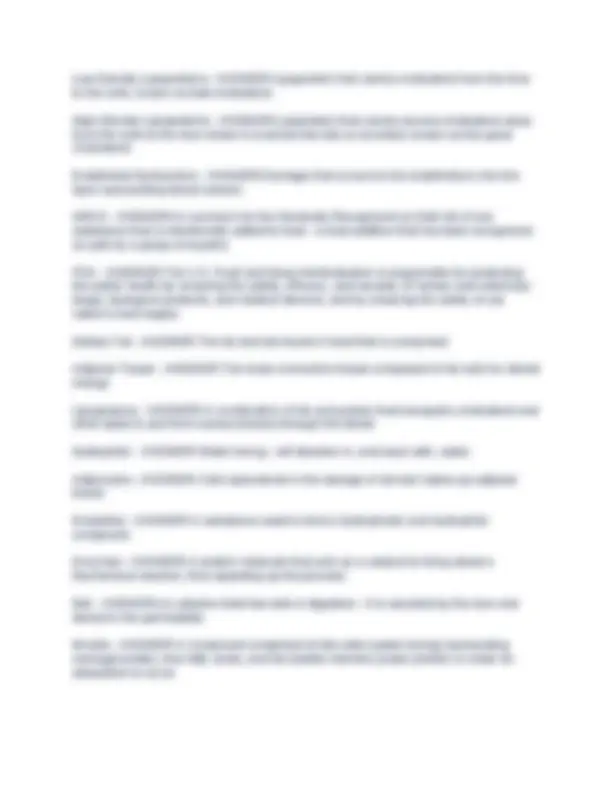
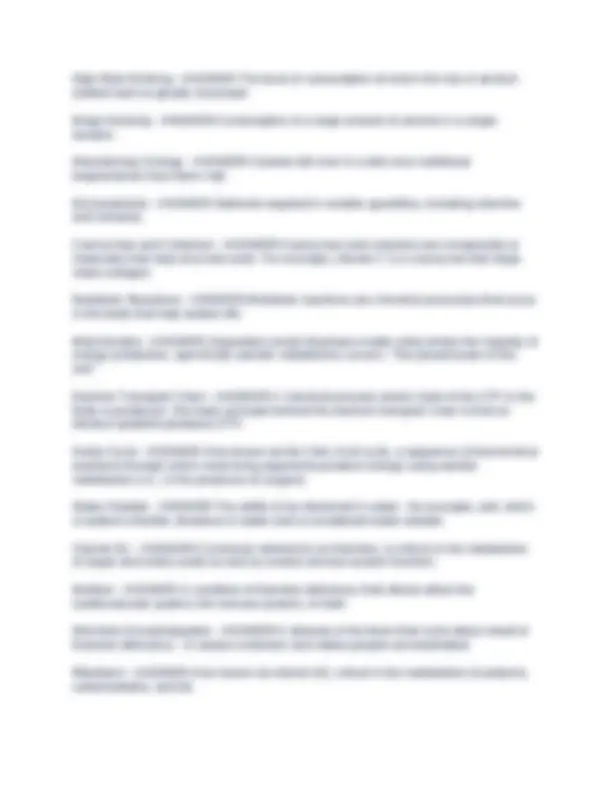
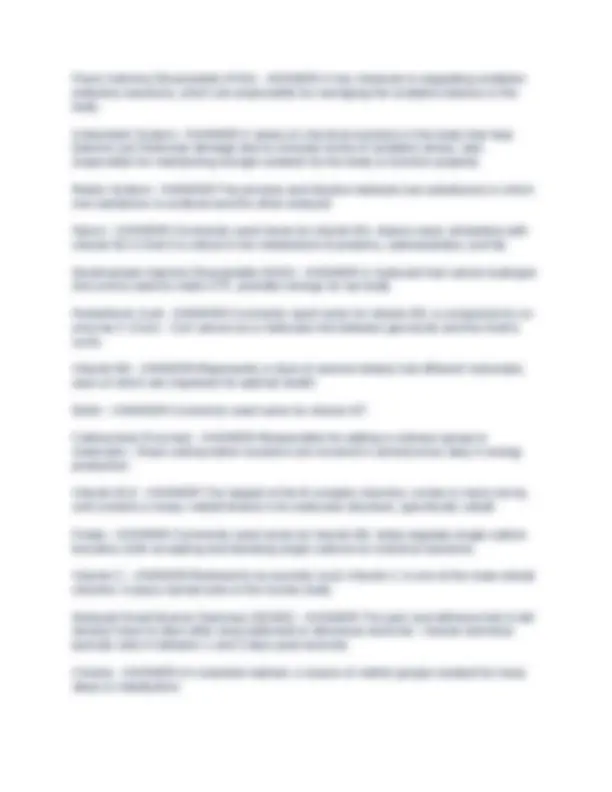
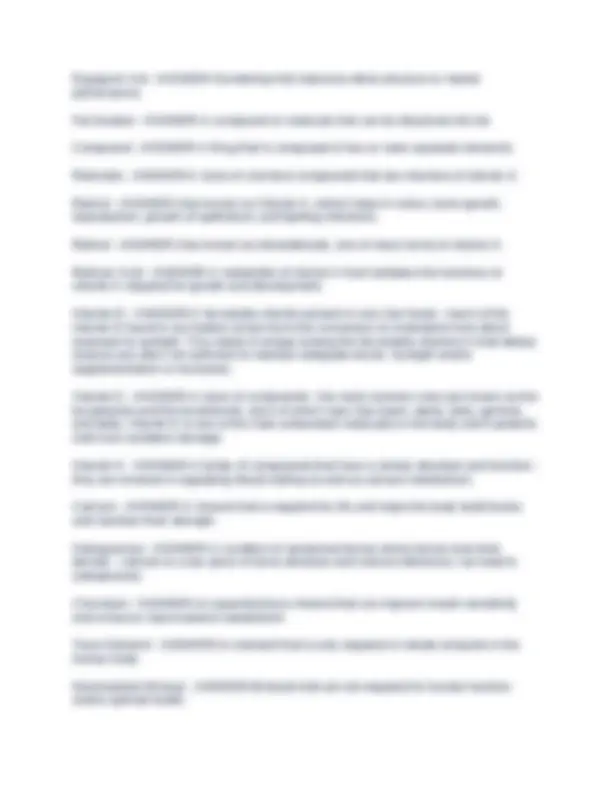
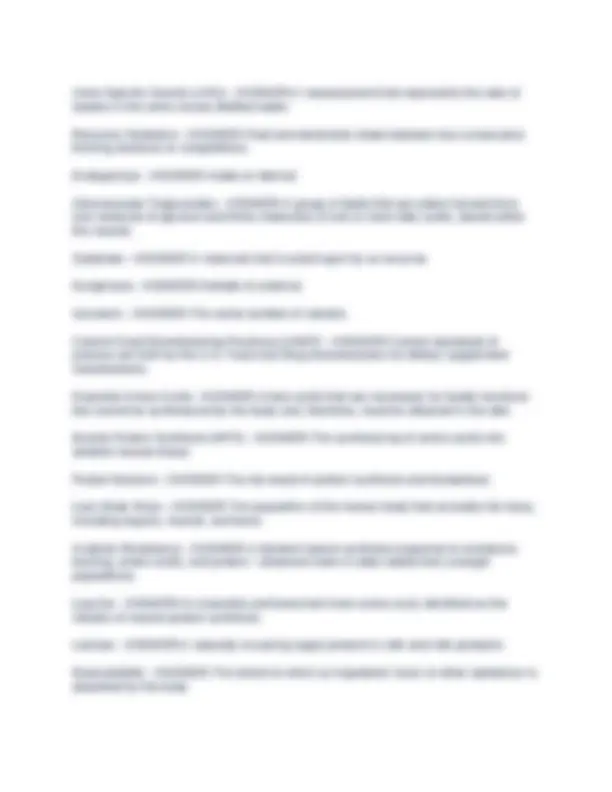



Study with the several resources on Docsity

Earn points by helping other students or get them with a premium plan


Prepare for your exams
Study with the several resources on Docsity

Earn points to download
Earn points by helping other students or get them with a premium plan
Community
Ask the community for help and clear up your study doubts
Discover the best universities in your country according to Docsity users
Free resources
Download our free guides on studying techniques, anxiety management strategies, and thesis advice from Docsity tutors
Scope of Practice - ANSWER-The actions, procedures, and processes that a professional is allowed to undertake in keeping with the terms of the professional's license or credential. Registered Dietitian Nutritionist (RDN) - ANSWER-This term is used interchangeably with a Registered Dietitian (RD) and it is also
Typology: Exams
1 / 19

This page cannot be seen from the preview
Don't miss anything!












Scope of Practice - ANSWER-The actions, procedures, and processes that a professional is allowed to undertake in keeping with the terms of the professional's license or credential. Registered Dietitian Nutritionist (RDN) - ANSWER-This term is used interchangeably with a Registered Dietitian (RD) and it is also a legally protected designation. Commission on Dietetic Registration (CDR) - ANSWER-The CDR acts as the credentialing arm of the Academy of Nutrition and Dietetics for the purpose of establishing and enforcing certification standards for registered dieticians and other licensed nutritional professionals and issues credentials to those who successfully meet said standards. The CDR also provides a professional code of ethics and recertification standards. Certified Diabetes Educator (CDE) - ANSWER-A licensed healthcare professional or certified allied health professional who works with those who have diabetes - 1000 contact hours in diabetes education is required for certification. Advanced Registered Nurse Practitioners - ANSWER-An advanced nursing degree requiring 2 more years of college beyond an RN - many then choose a specialty or primary focus of care. Physician Assistant (PA) - ANSWER-A licensed healthcare professional who works under the supervision of a doctor or other medical professional, typically requires a 4- year degree plus a post-graduate program. Doctor of Pharmacy (PharmD) - ANSWER-A pharmacist with an advanced degree who works in conjunction with a medical doctor to prepare and/or dispense prescription drugs or compounds. Licensed - ANSWER-Licensing is typically provided on a state or federal level. Common prerequisites of licensing include formal education/training, a predetermined number of supervised contact hours, and successful completion of a standardized test. Most healthcare providers require licensure. Certified - ANSWER-Certification is granted to a person who has participated in an educational course (either live or online) and successfully completed a standardized test: written, practical, or both.
Nutritionist - ANSWER-A generic term for someone who provides nutrition counseling - certification and licensing parameters are vague Macronutrients - ANSWER-Nutrients required in large quantities, including carbohydrates, proteins, and fats. Micronutrients: - ANSWER-Nutrients required in smaller quantities, including vitamins and minerals. The SCOFF Questionnaire - ANSWER-Basic yet reliable set of five questions that help assess whether an eating disorder exists. Hypoglycemia - ANSWER-A condition of an abnormally low blood glucose (blood sugar) level in the blood. Science - ANSWER-A method of attempting to arrive at objective truths. Hypothesis - ANSWER-A proposed explanation for a problem or set of observations. The Scientific Method - ANSWER-The process of formulating explanations about the natural world and testing those explanations with experiments and data. Evidence-Based Practice - ANSWER-A three-pronged approach to working with clients, which consists of making decisions based on the weight of the scientific evidence, field observations, and individual client needs and preferences. Prediction - ANSWER-An expected outcome generated from a hypothesis. Theory - ANSWER-A hypothesis or set of hypotheses for which a large body of high- quality evidence has been accumulated. Anecdote - ANSWER-An account of a person's experience or event. Uncontrolled Variable - ANSWER-A variable in an experiment that a scientist makes no effort to manipulate or account for. Observational Research - ANSWER-Research in which a researcher observes ongoing behaviors to determine correlation. Correlation - ANSWER-A relationship between two or more variables. Randomized Control Trial (RCT) - ANSWER-A type of scientific study/trial where participants are randomly assigned into different groups - one or more will be the intervention to be tested and one will be the control group. Groups are randomized and a control is used in an attempt to reduce potential bias in the trial.
Wellness - ANSWER-The fluid process of improving the emotional, occupational, physical, social, intellectual, and spiritual components of life, dynamically leading to a better state of health and well-being. Obese - ANSWER-A high degree of excess body fat - a BMI greater than 30. Biometrics - ANSWER-The technical term for measurements and calculations related to human physical characteristics. Satiety - ANSWER-A feeling of fullness and satisfaction. Palatability - ANSWER-The degree of pleasure or taste provided by a food - a highly palatable food is one that is tasty and pleasant to consume. Adenosine Triphosphate (ATP) - ANSWER-The energy currency of life. Energy - ANSWER-The ability to do work. Metabolism - ANSWER-Chemical processes occurring within the body to convert food to energy. Lipogenesis - ANSWER-The biological process of combining free fatty acids with glycerol to form triglycerides. Lipolysis - ANSWER-The biological process of breaking stored triglycerides into free fatty acids and glycerol. Glycogenolysis - ANSWER-The process of breaking down the glycogen molecule into its individual glucose units for entry into the energy pathways. Gluconeogenesis - ANSWER-A metabolic pathway that results in the generation of glucose from non-carbohydrate carbon substrates such as lactate, glycerol and glucogenic amino acids. Glycolysis - ANSWER-The first step of carbohydrate metabolism, an anaerobic pathway, that breaks glucose or glycogen down to pyruvate. Acid-Base Balance - ANSWER-The process of achieving, or the state of, equilibrium between acidic and alkaline molecules. Cell Signaling - ANSWER-Process of communication between cells by biological messengers to govern cellular function. Organic Molecules - ANSWER-Chemical structures containing only carbon, hydrogen, oxygen, and/or nitrogen.
Amino Acids - ANSWER-The organic building blocks of proteins containing both a carboxyl and an amino group. Essential Amino Acid (EAA) - ANSWER-Amino acids that are necessary for bodily functions but cannot be synthesized by the body and, therefore, must be obtained in the diet. Branched Chain Amino Acid - ANSWER-The three essential amino acids (leucine, isoleucine, and valine) which are abundant in skeletal muscle tissue and named for their branch-like structure. Conditionally Essential Amino Acids - ANSWER-Amino acids that are not typically essential, but can become essential during times of extreme dietary insufficiency, illness, or trauma. Nonessential Amino Acids - ANSWER-Amino acids that can be synthesized by the body and do not, under normal circumstances, need to be obtained in the diet. Protein Synthesis - ANSWER-Process of joining amino acids with peptide bonds to form proteins. Dehydration Synthesis - ANSWER-The joining of two large molecules by removing one hydrogen from one molecule and a hydroxyl group (OH) from another molecule and then binding the two larger molecules together on the newly freed bonds. Peptide Bond - ANSWER-The bond between two amino acids, occurring between the carboxyl group of one and the amino group of the other. Hydrolysis - ANSWER-Breakdown of one large molecule into two smaller molecules via the donation of one hydrogen and one hydroxyl group from water to the smaller molecules, respectively. Dipeptide - ANSWER-A chain of two amino acids. Tripeptide - ANSWER-A chain of three amino acids. Oligopeptide - ANSWER-A chain of four to nine amino acids. Polypeptide - ANSWER-A chain of 10 or more amino acids. Denaturation - ANSWER-The process of changing a proteins shape. Gastrin - ANSWER-A hormone released when food is ingested to stimulate release of digestive fluids.
Protein Quality - ANSWER-The quantity of essential amino acids found in, and the digestibility of, a protein. Complete Protein - ANSWER-A protein that contains sufficient quantities of all essential amino acids. Complementary Protein - ANSWER-Two incomplete proteins that, when consumed together, mimic a complete protein by providing all essential amino acids. Monosaccharides - ANSWER-They define the single sugar units of glucose, fructose, and galactose and represent the absorbable forms of carbohydrates for the body. Disaccharides - ANSWER-They define pairs of sugar units. The three nutritionally important ones to humans are sucrose, maltose, and lactose. Polysaccharides - ANSWER-They define glucose chains longer than 10 units in length, but they can be as large as several thousand glucose units in length. Oligosaccharides - ANSWER-They define sugar units ranging from 3 to 10 units in length and are largely indigestible to humans. Amylose - ANSWER-A straight-chain and digestible form of starch containing glucose molecules. Amylopectin - ANSWER-A branched-chain and digestible form of starch containing glucose molecules. Soluble Fiber - ANSWER-A type of dietary fiber that dissolves in water to form a gel, associated with heart health benefits and glucose control. Insoluble Fiber - ANSWER-A type of dietary fiber that does not dissolve in water, associated with promoting bowel regularity. Diverticulosis - ANSWER-A condition that occurs when pockets of collected stool called diverticula form in the walls of the digestive tract, forcing the inner layer of the intestinal wall to push through its outer lining. Functional Fiber - ANSWER-A compound derived from isolated indigestible fiber to potentially provide some of the health-promoting benefits of natural fiber. Glycogen - ANSWER-The storage molecule of carbohydrate found in animals and located in muscle and liver cells. Glycogenesis - ANSWER-The process of forming glycogen from glucose.
Triglycerides - ANSWER-The primary storage and transportable form of fats in the body, composed of three free fatty acids bound to a glycerol backbone. Ketones - ANSWER-A group of incompletely metabolized fat fragments that are normally produced during fat metabolism in the absence of adequate carbohydrates. Bolus - ANSWER-A mass of food that has been chewed and is now ready to initiate the swallowing process. Chyme - ANSWER-The partially digested, semi-fluid mass of food expelled by the stomach to the duodenum. Jejunum - ANSWER-It is the second section of the small intestine where digestion and absorption occur. It is located immediately after the duodenum and leads into the ileum. Ileum - ANSWER-It is the final section of the small intestine where lots of absorption occurs. It is located immediately after the jejunum and leads into the large intestine. Brush Border - ANSWER-The wall of the small intestine, composed of villi and microvilli, that enhance the region's surface area for the final stages of digestion and absorption. Villi - ANSWER-These are small, finger-like projections located on the walls of the intestine that extend into the intestinal tract that serve to increase the body's surface area for absorption of nutrients. Cirrhosis - ANSWER-A liver disease marked by the replacement of healthy liver tissue with scar tissue that is a result of alcohol abuse. Non-Alcoholic Fatty Liver Disease - ANSWER-The development of a fatty liver resulting from excessive quantities of fats being deposited from causes that exclude alcohol. Hyperglycemia - ANSWER-A condition of an abnormally high blood glucose (blood sugar) level in the blood. Type 1 Diabetes - ANSWER-A condition in which the pancreas produces little to no insulin. Catabolic - ANSWER-The breakdown of nutrients to release energy. Glycemic Load - ANSWER-A method for determining how the quantity of carbohydrates consumed impact blood sugar levels. Hydrophobic - ANSWER-Water fearing - will not dissolve in, or react with, water. Cardiovascular Disease - ANSWER-Conditions involving the narrowing or blockage of blood vessels that can cause a heart attack, chest pain, or stroke.
Low-Density Lipoproteins - ANSWER-Lipoprotein that carries cholesterol from the liver to the cells, known as bad cholesterol. High-Density Lipoproteins - ANSWER-Lipoprotein that carries excess cholesterol away from the cells to the liver where it is turned into bile or excreted, known as the good cholesterol. Endothelial Dysfunction - ANSWER-Damage that occurs to the endothelium, the thin layer surrounding blood vessels. GRAS - ANSWER-An acronym for the Generally Recognized as Safe list of any substance that is intentionally added to food - a food additive that has been recognized as safe by a group of experts. FDA - ANSWER-The U.S. Food and Drug Administration is responsible for protecting the public health by ensuring the safety, efficacy, and security of human and veterinary drugs, biological products, and medical devices, and by ensuring the safety of our nation's food supply. Dietary Fat - ANSWER-The fat and oils found in food that is consumed. Adipose Tissue - ANSWER-The loose connective tissue composed of fat cells for stored energy. Lipoproteins - ANSWER-A combination of fat and protein that transports cholesterol and other lipids to and from various tissues through the blood. Hydrophilic - ANSWER-Water loving - will dissolve in, and react with, water. Adipocytes - ANSWER-Cells specialized in the storage of fat that makes up adipose tissue. Emulsifier - ANSWER-A substance used to bind a hydrophobic and hydrophilic compound. Enzymes - ANSWER-A protein molecule that acts as a catalyst to bring about a biochemical reaction, thus speeding up the process. Bile - ANSWER-An alkaline fluid that aids in digestion - it is secreted by the liver and stored in the gall bladder. Micelle - ANSWER-A compound comprised of bile salts (water-loving) surrounding monoglycerides, free fatty acids, and fat-soluble vitamins (water phobic) in order for absorption to occur.
Lymphatic System - ANSWER-An extensive network of vessels passing through almost all bodily tissues that produce and transport lymph (colorless fluid of white blood cells). Lipoprotein Lipase - ANSWER-An enzyme found in the endothelium of the cells that breaks down triglycerides into fatty acids and a glycerol for the cell to use. Endothelium - ANSWER-Cells that line the inner surface of blood vessels and other lymphatic tissue. Low-Density Lipoprotein - ANSWER-Lipoprotein that carries cholesterol from the liver to the cells, known as bad cholesterol. High-Density Lipoprotein - ANSWER-Lipoprotein that carries excess cholesterol away from the cells to the liver where it is turned into bile or excreted, known as the good cholesterol. Beta-Oxidation - ANSWER-The process that occurs within the cell's mitochondria to produce glycerol and fatty acids. Acetyl CoA - ANSWER-A molecule that participates in biochemical reactions in protein, carbohydrate, and lipid metabolism, producing energy. Ketone Bodies - ANSWER-A group of incompletely metabolized fat fragments that are normally produced during fat metabolism in the absence of adequate carbohydrates. Essential Fatty Acids - ANSWER-Fatty acids that cannot be synthesized, or not in adequate amounts, and, therefore have to be consumed in the diet - they include omega-3 and omega-6 fatty acids. Fat-Soluble Vitamins - ANSWER-Fat soluble means that a compound or molecule can be dissolved into fat. Fat-soluble vitamins include A, D, E, and K. Omega-3s (a-Linolenic) - ANSWER-Named based on the position of the first double bond in the carbon chain, Carbon 3, an essential polyunsaturated fatty acid that is found in fish, seafood, flaxseed oil, and walnuts. Omega-6s (a-Linoleic) - ANSWER-Named based on the position of the first double bond in the carbon chain, Carbon 6, an essential polyunsaturated fatty acid that is found primarily in plant oils such as corn, soybean, and safflower. EPA - ANSWER-Abbreviation for eicosapentaenoic acid, essential omega-3 fatty acid found in marine sources including fish and krill, serves as a precursor to various compounds that have anti-inflammatory activities in the body in addition to serving as structural components of the brain and eye tissue.
High-Risk Drinking - ANSWER-The level of consumption at which the risk of alcohol- related harm is greatly increased. Binge Drinking - ANSWER-Consumption of a large amount of alcohol in a single session. Discretionary Energy - ANSWER-Calories left over in a diet once nutritional requirements have been met. Micronutrients - ANSWER-Nutrients required in smaller quantities, including vitamins and minerals. Coenzymes and Cofactors - ANSWER-Coenzymes and cofactors are compounds or molecules that help enzymes work. For example, vitamin C is a coenzyme that helps make collagen. Metabolic Reactions - ANSWER-Metabolic reactions are chemical processes that occur in the body that help sustain life. Mitochondria - ANSWER-Organelles (small structures inside cells) where the majority of energy production, specifically aerobic metabolism, occurs - "the powerhouse of the cell." Electron Transport Chain - ANSWER-A chemical process where most of the ATP in the body is produced - the basic principle behind the electron transport chain is that an electron gradient produces ATP. Krebs Cycle - ANSWER-Also known as the Citric Acid cycle, a sequence of biochemical reactions through which most living organisms produce energy using aerobic metabolism (i.e., in the presence of oxygen). Water-Soluble - ANSWER-The ability to be dissolved in water - for example, salt, which is sodium-chloride, dissolves in water and is considered water-soluble. Vitamin B1 - ANSWER-Commonly referred to as thiamine, is critical in the metabolism of sugar and amino acids as well as central nervous system function. Beriberi - ANSWER-A condition of thiamine deficiency that affects either the cardiovascular system, the nervous system, or both. Wernicke Encephalopathy - ANSWER-A disease of the brain that is the direct result of thiamine deficiency - It causes confusion and makes people uncoordinated. Riboflavin - ANSWER-Also known as vitamin B2, critical in the metabolism of proteins, carbohydrates, and fat.
Flavin Adenine Dinucleotide (FAD) - ANSWER-A key molecule in regulating oxidation- reduction reactions, which are responsible for managing the oxidative balance in the body. Antioxidant System - ANSWER-A series of chemical reactions in the body that help balance out molecular damage due to increase levels of oxidative stress, also responsible for maintaining enough oxidants for the body to function properly. Redox System - ANSWER-The process and reaction between two substances in which one substance is oxidized and the other reduced. Niacin - ANSWER-Commonly used name for vitamin B3, shares many similarities with vitamin B2 in that it is critical in the metabolism of proteins, carbohydrates, and fat. Nicotinamide Adenine Dinucleotide (NAD) - ANSWER-A molecule that carries hydrogen ions and is used to make ATP, provides energy for our body. Pantothenic Acid - ANSWER-Commonly used name for vitamin B5, a component to co- enzyme A (CoA) - CoA serves as a molecular link between glycolysis and the Kreb's cycle. Vitamin B6 - ANSWER-Represents a class of several related, but different molecules, each of which are important for optimal health. Biotin - ANSWER-Commonly used name for vitamin B7. Carboxylase Enzymes - ANSWER-Responsible for adding a carboxyl group to molecules - these carboxylation reactions are involved in almost every step in energy production. Vitamin B12 - ANSWER-The largest of the B-complex vitamins, comes in many forms, and contains a heavy metal/mineral in its molecular structure, specifically cobalt. Folate - ANSWER-Commonly used name for vitamin B9, helps regulate single-carbon transfers, both accepting and donating single carbons to chemical reactions. Vitamin C - ANSWER-Referred to as ascorbic acid, Vitamin C is one of the more robust vitamins. It plays myriad roles in the human body. Delayed-Onset Muscle Soreness (DOMS) - ANSWER-The pain and stiffness that is felt several hours to days after unaccustomed or strenuous exercise - muscle soreness typically sets in between 1 and 3 days post exercise. Choline - ANSWER-An essential nutrient, a source of methyl groups needed for many steps in metabolism.
Goiter - ANSWER-The swelling of the neck resulting from enlargement of the thyroid gland. Hypothyroidism - ANSWER-A condition in which your thyroid does not produce enough thyroid hormones. Myoglobin - ANSWER-A protein that carries and stores oxygen in muscle cells. Heme - ANSWER-A form of dietary iron found only in animal meat. Nonheme - ANSWER-A form of dietary iron found in plant-based foods. Magnesium - ANSWER-A mineral that is required for energy production, oxidative phosphorylation, and glycolysis. Mercury - ANSWER-A trace element that finds its way into the human diet, has no necessary function, and is highly toxic, especially during development in utero and early childhood. Potassium - ANSWER-A mineral that is present in all tissues in the body and is required for maintaining concentration gradients, fluid volume, and cardiac rhythm. Hypokalemia - ANSWER-A condition where the concentration of potassium in the blood drops below normal levels. Selenium - ANSWER-The key component of several selenoproteins that serve as antioxidants or in the regeneration of antioxidants. Sodium - ANSWER-A mineral that is present in virtually every tissue of the body and is essential for maintaining gradient balance, fluid status, and cardiac rhythm. Hyponatremia - ANSWER-A condition where the concentration of sodium in the blood drops below normal levels - this often happens when people sweat a lot or consume too much water and not enough electrolytes. Zinc - ANSWER-A mineral that provides structure to cells and helps reactions occur - it is the most abundant intracellular of the trace elements and plays regulatory roles in transcription via transcription factors, stabilizes nucleic acids, and is neccesary for the creation of tubulin, giving cells their internal rigid structure and allowing them to properly maintain their shape and function. Bioavailability - ANSWER-The extent to which an ingredient, food, or other substance is absorbed by the body.
Estimated Average Requirement (EAR) - ANSWER-A nutrient intake value that is estimated to meet the requirement of half the healthy individuals in a group. Tolerable Upper Intake Level (UL) - ANSWER-The highest level of daily nutrient intake that is likely to pose no risk of adverse health effects to almost all individuals in the general population - as intake increases above the UL, the risk of adverse effects increases. Intracellular Fluid (ICF) - ANSWER-The water contained within a cell's membrane, makes up approximately 2/3 of total body water. Extracellular Fluid (ECF) - ANSWER-The water found outside of the body's cells - ECF is found between cells and transported throughout the body via arteries, veins, and capillaries. Osmolality - ANSWER-Describes the concentration of solutes in a liquid - various compartments hold fluids but the primary regulator of hydration status is the osmolality of ECF, specifically plasma osmolality. Multiple sites in the body house osmoreceptors that detect shifts in osmolality and generate responses to return the body to fluid and sodium homeostasis. Dipsogenic Signal - ANSWER-Physiological factors such as high osmolality or low blood pressure, which prompt sodium and water appetite. Baroreceptors - ANSWER-Specialized nerves that can sense change in pressure in the heart or blood vessels. Hypo-Osmotic - ANSWER-A solution with a lesser concentration of solute (i.e., fresh water compared to salt water). Gastric Emptying Rate (GER) - ANSWER-The rate at which fluids and their contents pass through the stomach via the pyloric sphincter and into the small intestine - the faster and more complete the GER, the more quickly carbohydrates and electrolytes can be absorbed into the mesentery system, where they feed the liver first and then the rest of the body via the vascular system. Convection - ANSWER-The movement or flow of air over an object. Euhydration - ANSWER-A normal hydration status. Ad Libitum - ANSWER-Translates to "as desired" and refers to eating or drinking as you are normally driven to (i.e., not purposely overeating or undereating). Exercise Associated Hyponatremia (EAH) - ANSWER-A potentially serious medical condition in which the plasma sodium falls below 135 mmol/L, usually the result of fluid intake greatly exceeding sweat losses during prolonged exercise.
Acceptable Macronutrient Distribution Range (AMDR) - ANSWER-A range of intakes for carbohydrates, protein, and fats set by the Food and Nutrition Board of the National Academy of Medicine recommended to meet the nutritional needs of most individuals and reduce risk of chronic disease.